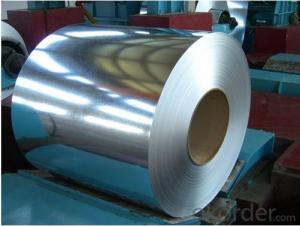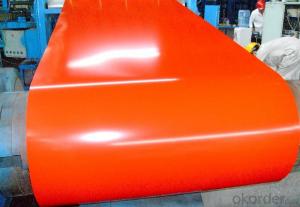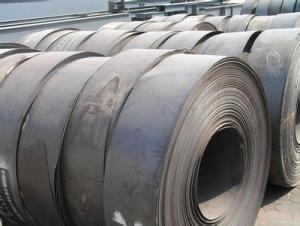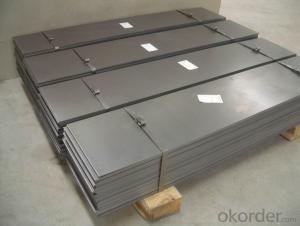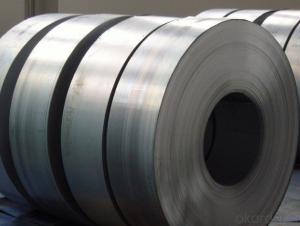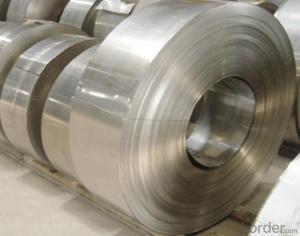Hod Dip Full Hard Galvanized Gi Steel Coil
- Loading Port:
- Tianjin
- Payment Terms:
- TT OR LC
- Min Order Qty:
- 50 m.t.
- Supply Capability:
- 3000 m.t./month
OKorder Service Pledge
OKorder Financial Service
You Might Also Like
Item specifice
Product Brief Introduction
Hot Dip Full Hard Galvanized Gi Steel Coil
--- Hot Dip Full Hard Galvanized Gi Steel Coil applies to construction field, ships building industry, petroleum,
chemical industries, war and electricity industries, food processing and medical industry,
boiler heat exchanger,machinery and hardware fields.
Product Features
. Traditional aesthetics outlook
. Suitable for new house or renovation.
. Long life service
. Tedun also provide relative ridge cap, fasteners and other accessories
Product Specification
Standard:ASTM, GB,JIS,JIS G3302 ASTM 755 EN10169
Grade: DX51D CGCC CS
Thickness: 0.12mm~4.0mm,
Width: 1250,600-1250mm
weight:3-12 MT
Chemical composition:
C | Si | Mn | Cr | Ni | P | S |
0.150 | 0.476 | 11.231 | 12.50 | 0.900 | 0.039 | 0.010
|
FAQ
1. How long will we receive the goods ?
45days after receiving workable L/C
1. how do you control the quality ?
we have our own quality control department ,we will arrange QC person to see the production line ,when goods finish ,before shipment ,our QC person will check the quality as per our test report request ,if the goods is ok ,then we issue the test report ,and we allow the goods shipping ,otherwise will not allow ship the goods.

- Q:Where is the lining board made of polyurethane lining? Please contact immediately
- Selection of raw materials: different polyol raw materials with different molecular structures and molecular weight, the performance gap between different polyols, the use of the environment and the requirements are not the same, each with unique characteristics and optimum application. Polyester polyol, wear resistance, corrosion resistance, good oil resistance, high mechanical strength, good aging resistance. Polyether polyols have good resilience and low temperature compliance, and they also have good hydrolytic stability and mildew resistance. There are many curing agents, and different formulation systems use different performance requirements. The choice of different systems depends not only on the performance requirements of the product, but also on the price of the product. The abrasion resistance of the wear-resistant lining plate is determined by the raw material chosen.
- Q:Can steel strips be used in the manufacturing of bicycles?
- Indeed, the utilization of steel strips is viable in the production process of bicycles. The prevalence of steel as a material in bicycle manufacturing arises from its robustness, longevity, and adaptability. Steel strips serve diverse purposes in the construction of bicycle components, including frames, forks, handlebars, and racks. Steel offers exceptional firmness and dependability, rendering it suitable for a wide range of riding circumstances and terrains. Furthermore, steel presents a relatively economical alternative when compared to materials like carbon fiber or aluminum, thus contributing to its widespread preference in the bicycle industry.
- Q:How are steel strips used in the production of solar panels?
- Integral to the production process of solar panels are steel strips. These strips serve primarily as frames and structural supports for the panels. They are typically crafted from galvanized steel, which is renowned for its durability and resistance to corrosion. To form the framework of the solar panel, specific lengths and shapes are cut into the steel strips. This framework holds all the panel components together, including the glass cover, solar cells, and backsheet. To ensure panel stability, especially during installation and exposure to diverse weather conditions, the steel strips are securely fastened. Furthermore, the steel strips play a crucial role in maintaining the overall integrity of the solar panel. They serve as a protective barrier, shielding the delicate components from external forces like wind, rain, and snow. By providing structural support, the steel strips prevent damage and ensure the panel's longevity. Moreover, the steel strips are indispensable for the installation and mounting of solar panels. They are used to firmly secure the panels onto rooftops or other surfaces. This ensures that the panels are securely fixed in place, maximizing exposure to sunlight and optimizing energy production. In conclusion, steel strips are a vital component in the production of solar panels. They provide structural support, maintain panel integrity, and facilitate installation and mounting. By incorporating steel strips into the manufacturing process, solar panels become more robust, reliable, and efficient, contributing to the overall sustainability and effectiveness of solar energy systems.
- Q:How are steel strips used in the production of automotive body reinforcements?
- Steel strips are commonly used in the production of automotive body reinforcements due to their strength and durability. These strips are typically made from high-strength steel alloys that provide excellent structural integrity and resistance to deformation. In the manufacturing process, steel strips are first cut into specific lengths and then formed into desired shapes using various techniques such as bending, stamping, or rolling. These formed strips are then welded or riveted together to create rigid structures that reinforce the body of the vehicle. Automotive body reinforcements play a critical role in enhancing the overall strength and safety of the vehicle. They provide additional support and rigidity to different parts of the car, such as the chassis, pillars, and door frames, which helps to protect occupants in the event of a collision. Steel strips are particularly favored in the production of automotive body reinforcements due to their high tensile strength, which allows them to withstand significant forces and impacts. Additionally, steel is readily available, cost-effective, and easily customizable, making it an ideal material for mass production in the automotive industry. Furthermore, steel strips can be designed to have specific properties, such as corrosion resistance or improved crashworthiness, to meet the stringent safety and performance standards required in the automotive sector. This flexibility in design allows manufacturers to tailor the reinforcements to the specific needs of different vehicle models. Overall, steel strips are essential components in the production of automotive body reinforcements as they provide the necessary strength, durability, and customization options required to ensure the safety and structural integrity of modern vehicles.
- Q:What are the different surface printing methods for steel strips?
- Some of the different surface printing methods for steel strips include screen printing, pad printing, and hot foil stamping.
- Q:What are the main challenges in handling and storing steel strips?
- The main challenges in handling and storing steel strips include their weight and size, susceptibility to corrosion, proper stacking and storage techniques, and maintaining a controlled environment to prevent damage.
- Q:Can steel strips be used in the renewable energy sector?
- The renewable energy sector can indeed make use of steel strips. These strips possess great versatility and can be applied in various ways within this sector. To illustrate, they find utility in constructing wind turbines, mounting solar panels, and other infrastructure projects connected to generating renewable energy. In the case of wind turbines, steel strips serve as raw materials for manufacturing turbine towers. These towers must be robust and long-lasting to endure the wind's force. Steel strips offer the required strength and stability, rendering them a perfect selection. Moreover, steel strips frequently feature in the creation of solar panel mounting systems. These systems are responsible for securing solar panels in position, guaranteeing optimal sunlight exposure. Given their strength, resistance to corrosion, and economical nature, steel strips are often employed as a structural element. Additionally, steel strips can also be employed in constructing other renewable energy infrastructure, such as hydroelectric and geothermal power plants. These plants necessitate sturdy structures and components, and steel strips can meet the demand for strength and durability. To sum up, steel strips possess a broad range of applications in the renewable energy sector. Their strength, versatility, and cost-effectiveness make them an apt choice for diverse renewable energy projects. Consequently, they contribute to the advancement and expansion of sustainable energy sources.
- Q:How are steel strips polished for aesthetic purposes?
- Steel strips are polished for aesthetic purposes using a combination of mechanical processes such as grinding, buffing, and polishing. These techniques involve the use of abrasive materials and machines to remove surface imperfections and create a smooth, shiny finish on the steel strips. Additionally, chemical treatments may be applied to enhance the polishing process and achieve the desired aesthetic results.
- Q:Can steel strips be used for making electrical connectors in power distribution systems?
- Yes, steel strips can be used for making electrical connectors in power distribution systems. Steel strips provide several advantages for this application. Firstly, steel is a highly conductive material, making it suitable for carrying electrical current. It has a low resistance, which ensures minimal power loss during transmission and distribution. Steel also has good mechanical properties, allowing it to withstand the stresses and strains experienced in power distribution systems. Additionally, steel strips can be easily formed into various shapes and sizes, making them versatile for designing different types of connectors. They can be bent, punched, or welded to create specific connection points for electrical cables. Steel strips can also be coated with a protective layer, such as tin or nickel, to improve their corrosion resistance and electrical conductivity. Furthermore, steel is a durable and long-lasting material, capable of withstanding harsh environmental conditions and providing reliable electrical connections over an extended period. This durability is crucial in power distribution systems, where connectors must maintain their integrity and conductivity under high voltage and current levels. However, it is important to note that steel strips may not be suitable for all types of electrical connectors. In certain applications, where higher electrical conductivity or specific mechanical properties are required, other materials like copper or aluminum may be preferred. The choice of material for electrical connectors depends on various factors such as the specific requirements of the power distribution system, cost considerations, and industry standards.
- Q:What is the maximum weight capacity of steel strips?
- The maximum weight capacity of steel strips can vary depending on various factors such as the thickness, width, and length of the strips. Generally, steel strips can have weight capacities ranging from a few hundred pounds to several thousand pounds. It is important to consult specific product specifications or industry standards to determine the exact maximum weight capacity of steel strips for a particular application.
1. Manufacturer Overview |
|
|---|---|
| Location | |
| Year Established | |
| Annual Output Value | |
| Main Markets | |
| Company Certifications | |
2. Manufacturer Certificates |
|
|---|---|
| a) Certification Name | |
| Range | |
| Reference | |
| Validity Period | |
3. Manufacturer Capability |
|
|---|---|
| a)Trade Capacity | |
| Nearest Port | |
| Export Percentage | |
| No.of Employees in Trade Department | |
| Language Spoken: | |
| b)Factory Information | |
| Factory Size: | |
| No. of Production Lines | |
| Contract Manufacturing | |
| Product Price Range | |
Send your message to us
Hod Dip Full Hard Galvanized Gi Steel Coil
- Loading Port:
- Tianjin
- Payment Terms:
- TT OR LC
- Min Order Qty:
- 50 m.t.
- Supply Capability:
- 3000 m.t./month
OKorder Service Pledge
OKorder Financial Service
Similar products
New products
Hot products
Related keywords
